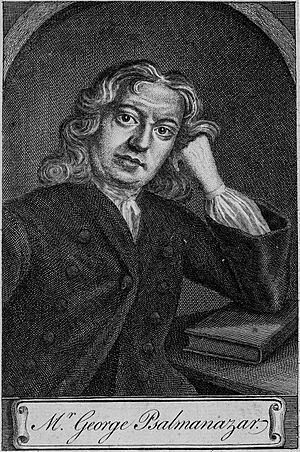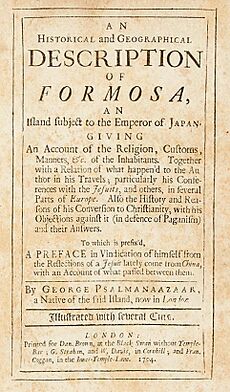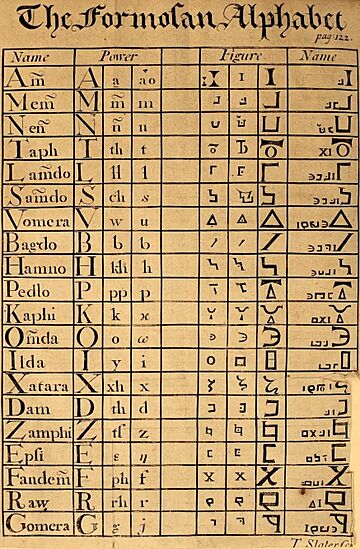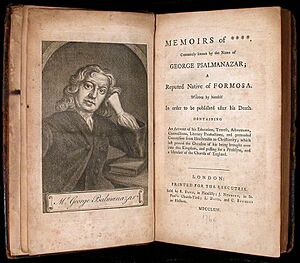George Psalmanazar facts for kids
George Psalmanazar (born around 1679, died May 3, 1763) was a man from France. He became famous for pretending to be the first person from Formosa (which is now Taiwan) to ever visit Europe. For several years, many people in Britain believed his story. But eventually, it was discovered that he was actually from Europe. After this, he changed his life and became a writer on religious topics. He even became friends with important people in London, like Samuel Johnson.
Contents
Early Life of George Psalmanazar
George Psalmanazar kept many details about his early life a secret. However, it is thought he was born in southern France, perhaps in Languedoc or Provence. This was sometime between 1679 and 1684. We do not know his real birth name.
In his autobiography, published after his death, he said he went to a Franciscan school. Then he attended a Jesuit academy. He claimed his teachers praised him for being very good at learning languages. He said he could speak Latin fluently by age seven or eight. He even did better than children twice his age.
However, he became unhappy with school after meeting a philosophy tutor. He stopped his education when he was about fifteen or sixteen years old.
Becoming an Impostor
George Psalmanazar decided to pretend to be someone else to travel easily.
Travels in Europe
First, he pretended to be an Irish pilgrim going to Rome. He learned English and even stole a pilgrim's cloak and staff. But many people knew about Ireland and quickly saw through his disguise.
He then decided he needed a more unusual disguise. He remembered stories about East Asia from his Jesuit teachers. So, he chose to pretend he was a Japanese convert. He even added strange habits to his act. He ate raw meat with cardamom spice and slept sitting upright in a chair.
Psalmanazar traveled through different German areas between 1700 and 1702. In 1702, he arrived in the Netherlands. There, he worked as a soldier sometimes. By this time, he had changed his made-up homeland from Japan to Formosa (Taiwan). This place was even less known. He made up more detailed customs, like a special calendar. He also pretended to worship the Sun and Moon with invented ceremonies. He even spoke a language he had created himself.
In late 1702, Psalmanazar met Alexander Innes, a Scottish priest. Innes later claimed he had converted Psalmanazar to Christianity. He gave him the name George Psalmanazar. In 1703, they traveled to London. They planned to meet important Anglican church leaders there.
Fame in England
When they arrived in London, news of the strange foreigner spread quickly. Psalmanazar became very famous. People were interested in his unusual ways. His story also fit with the anti-Catholic feelings in Britain at that time.
He claimed that evil Jesuits had kidnapped him from Formosa. He said they took him to France, where he refused to become Catholic. Psalmanazar said he was now a Christian who followed Anglicanism. He became a favorite of the Bishop of London and other important people.
In 1704, Psalmanazar published a book called An Historical and Geographical Description of Formosa. This book claimed to describe Formosan customs, land, and economy. But it was all made up. The "facts" in the book were a mix of other travel stories. They were especially influenced by accounts of the Aztec and Inca civilizations. Thomas More's Utopia might have also given him ideas.
Psalmanazar said Formosa was a rich country with a capital city called Xternetsa. Their main food was a type of serpent. They hunted it with tree branches. They used horses and camels for travel. He also claimed they lived underground in round houses.
Inventing a Language
Psalmanazar's book also described the Formosan language. This was an early example of a constructed language, meaning a language that someone invents. His invented language was so believable that German experts included samples of his "Formosan alphabet" in language books for many years. This happened even after his main trick was found out.
Here is his "translation" of the Lord's Prayer into his invented Formosan language:
Amy Pornio dan chin Ornio vicy, Gnayjorhe
sai Lory, Eyfodere sai Bagalin, jorhe sai domion apo chin Ornio, kay chin Badi eyen, Amy khatsada nadakchion toye ant nadayi, kay Radonaye ant amy Sochin, apo ant radonern amy Sochiakhin, bagne ant kau chin malaboski, ali abinaye ant tuen Broskacy, kens sai vie Bagalin, kay Fary, kay
Barhaniaan chinania sendabey. Amien.
Psalmanazar's book was a huge success. It had two English versions and was also published in French and German. After his book came out, he was asked to give talks about Formosan culture and language. He even spoke before the Royal Society, a famous group of scientists. There, he was questioned by Edmond Halley, a well-known astronomer.
Many people doubted Psalmanazar, but he usually managed to explain away their questions. For example, he said his pale skin was because the rich people in Formosa lived underground. Missionaries who had actually been to Formosa were not believed. This was probably because of strong feelings against Jesuits at the time.
The Formosan language he created has special codes in language registries. These are qfoart-x-formosan
Later Life and Confession
A New Path
Eventually, Psalmanazar's claims became less believable. More information about real Formosa started to come out. He began to defend his story less strongly. In 1706, he confessed that he had made it all up. He first told his friends, and then the public. By then, London society was mostly tired of the "Formosan craze."
In the years that followed, Psalmanazar worked as a clerk in an army group. Later, some church leaders gave him money to study religion. Psalmanazar then joined a group of writers in London. He wrote small books, edited other books, and did other low-paying writing jobs.
He learned Hebrew. He also helped write a book called A General History of Printing (1732). He wrote many articles for the Universal History. He even wrote about the real conditions in Formosa for another book. In this, he openly criticized the trick he himself had played. He seemed to become more religious and regretted his youthful lies. This led him to publish a book of religious essays in 1753.
Friends with Famous Writers
This later part of Psalmanazar's life brought him less fame than his time as a fraud. But it led to some interesting connections. One of the most famous was his friendship with the young writer Samuel Johnson. Johnson later remembered Psalmanazar as a kind and respected person in his neighborhood. He said that almost everyone, even children, showed him respect.
Psalmanazar also met other important English writers. In 1741, he sent the novelist Samuel Richardson about forty handwritten pages. He tried to continue the story of Richardson's popular novel Pamela. Richardson called Psalmanazar's attempt "ridiculous and improbable."
Death and Autobiography
George Psalmanazar died on May 3, 1763, in London, England. In his will, he described himself as a "poor, sinful and worthless creature." He asked to be buried simply and cheaply in a common burial ground. He also clearly stated that his History of Formosa was a "base and shameful imposture," a trick played on the public.
He left behind an autobiography called Memoirs of , Commonly Known by the Name of George Psalmanazar; a Reputed Native of Formosa. It was published in 1764. The book does not reveal his real birth name, which is still unknown. But it gives many details about his early life and how he developed his hoaxes.
See also
- Constructed writing system
- Travel literature
- Princess Caraboo
- Korla Pandit





